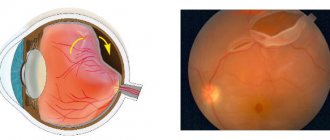Conjunctivitis occupies a leading place among ophthalmological diseases. This concept includes a whole group of inflammatory pathologies, ranging from allergic to infectious. Inflammation of the mucous membrane of the eyes is successfully treated. As a rule, drug treatment and the use of folk remedies are enough to completely get rid of it in 7-10 days. But why does the disease occur, how to promptly suspect its course and where to start therapy?
Share
Tweet
Share
Cool
Send
Main causes, characteristic symptoms of the disease
The causes of the disease depend on what form is diagnosed in a person. All causes of the disease can be conditionally grouped into two large groups:
- Infectious.
- Non-infectious (others).
Infectious microorganisms include pathogenic microorganisms that enter the conjunctiva and cause inflammation. It can be:
- bacteria (gonococcus, diphtheria or Pseudomonas aeruginosa, streptococcus, staphylococcus, meningococcus);
- viruses (herpes, adenovirus);
- chlamydia;
- pathogenic fungi (candida, spirotrichella, actinomycetes, aspergillus);
- allergens (plant pollen, dust, animal hair, contact lenses, as well as food, medicinal, seasonal allergens).
Non-infectious causes of conjunctivitis are various risk factors not associated with pathogenic particles. These include all kinds of exposure to chemicals, harmful production factors and gases, smoke, ultraviolet radiation, hypothermia, chronic eye diseases, excessive fatigue and overwork, etc.
The symptoms of the disease also depend on the form of conjunctivitis. The classic clinical picture for any form of the disease is the same, but the accompanying symptoms may be different and related to the underlying cause of the pathology.
Common symptoms of conjunctivitis:
- tearfulness;
- redness of the eyes;
- swelling and swelling of the eyelids;
- photophobia;
- pathogenic discharge from the eyes;
- discomfort when blinking, sensation of a foreign body in the eye.
Specific symptoms depend on the disease that caused conjunctivitis. Thus, infectious conjunctivitis, which developed as a result of influenza or ARVI, is accompanied by typical symptoms: sore throat, cough, nasal congestion and runny nose, fever. With the viral form, there is copious discharge from the eyes, but not purulent.
Allergic conjunctivitis occurs with swelling of the face and other parts of the body, nasal congestion, rashes, frequent sneezing and other signs of allergy.
Bacterial conjunctivitis, associated with the activity of pathogenic bacteria, is especially acute. Abundant accumulations of pus appear in the eyes, which prevent them from opening normally, causing itching and burning, and in some cases, pinpoint hemorrhages occur. The main hallmark of bacterial conjunctivitis is dry skin around the eyes.
In some cases, when conjunctivitis occurs, visual acuity begins to decrease. With timely treatment, vision can be completely restored.
A doctor can make an accurate diagnosis only after a detailed interview and taking a medical history. If you do not visit an ophthalmologist in the early stages of the disease or self-medicate, conjunctivitis can lead to serious complications, the most common of which are keratitis, otitis media, meningitis and sepsis.
Types of conjunctivitis
There are several types of conjunctivitis
- Allergic
- Bacterial
- Viral
- Herpetic
- Spicy
- Toxic
- Chlamydial
- Chronic
Allergic
It develops almost instantly upon contact with an allergen. Accompanied by lacrimation, severe inflammation, the eye swells, turns red, severe itching appears, and it hurts. There is often a feeling that something has gotten into the eye, and it becomes painful to look at the light. A secondary infection may be added to the inflammation, but this type of conjunctivitis is not contagious to others. Most often, both eyes are affected. This conjunctivitis is typical for people who have other allergic reactions, asthma, and eczema. This type of conjunctivitis occurs equally often in all ages.
People with allergic conjunctivitis feel especially unwell in dry and warm weather. If it's cool and damp outside, symptoms decrease.
The most common cause of this type of conjunctivitis is
- Flower pollen, poplar fluff
- Animal fur, secretions, saliva
- Strong odors
- Skin medications
- Cosmetics and household chemicals
- Air pollution, smoke
- Dust mites
- Eye drops
It occurs much less frequently with food allergies.
To prevent such conjunctivitis from occurring, it is necessary to remove the allergen that provokes it. Often this is enough to prevent it from occurring.
Also, one of the options for getting rid of allergies is to gradually accustom the body to the allergen. So, if you are allergic to animal fur, you can start by being in the same apartment with him, but in different rooms.
If this is not possible, you should consult a doctor for the necessary therapy. First aid may include taking antihistamines and applying cool compresses to the eyes.
Bacterial conjunctivitis
It is also called “purulent”, due to the fact that with this type of conjunctivitis, purulent discharge appears in the eyes. Caused by pyogenic bacteria. It is not very contagious unless you come into very close contact with someone who is sick. This type of conjunctivitis is not airborne; being in the same room with a sick person will not lead to infection. However, it is easy to become infected through physical contact - hugging, kissing. Sharing dishes, towels and linen can also be dangerous.
It manifests itself as severe redness of the sclera, lacrimation, and the victim complains of “sand” in the eyes. In the morning, when waking up, it can be difficult to open your eyes due to the fact that a purulent liquid of a grayish-yellow or greenish color has accumulated on the eyelashes. With it, the eyelids become crusty, they swell; in severe cases, the swelling can even spread to the cheeks. The patient's temperature rises and general weakness develops.
Treatment is prescribed exclusively by an ophthalmologist. For a complete cure, you should strictly follow his recommendations, otherwise there will be complications in the form of damage to your vision. This is especially true for newborns, in whom the pus can completely destroy the conjunctiva.
Viral conjunctivitis
A very contagious disease, transmitted contagiously - through hands, close contact, bed. It can easily get into your eyes if you simply rub them with dirty hands. Many of the sick remember that the day before they communicated with a person who was a carrier of this type of conjunctivitis. The incubation period is 5-7 days, sometimes it can reach up to 15. Most often it is caused by an adenovirus.
Most of the causes of such conjunctivitis are hospital-related. With it, other diseases occur simultaneously, especially of the upper respiratory tract. Most often, the disease goes away in both eyes - even if the infection initially affects only one eye, it very quickly spreads to the second. Very often, epidemics of this disease occur in children's groups - kindergartens, schools, etc. It also happens that a sick child will spend literally a few hours among healthy ones, and half of the children will become infected.
Viral conjunctivitis often accompanies other viral infections.
It is caused by the virus getting into the eyes. Often this is one of the accompanying infectious diseases, such as measles, scarlet fever, chickenpox and especially mumps. In this case, treatment of the underlying disease is prescribed, and during the healing process, conjunctivitis most often goes away. You just need to wash your eyes with herbal decoctions several times a day.
Viral conjunctivitis also includes herpetic conjunctivitis, as it is caused by the herpes virus. It occurs when immunity decreases, if a person is hypothermic, when other factors arise that provoke the occurrence of this infection.
Toxic conjunctivitis
It is also called medicinal. It occurs when the body is poisoned by toxic substances, most often drugs. Often the patient himself is to blame for its occurrence, who independently “prescribes” eye drops for himself at the slightest damage or eye disease. It can be classified as an allergic form of conjunctivitis; this form is not contagious to others, but it requires treatment by an ophthalmologist to avoid becoming chronic.
Chlamydial conjunctivitis
Caused by chlamydia. This type of conjunctivitis is contagious to others; the particular difficulty lies in the fact that these microorganisms occupy a niche between viruses and bacteria.
The main infection is in the genitourinary system. In most cases, a person becomes infected with this type of conjunctivitis himself when he transfers chlamydia into his eyes with dirty hands. However, you can also become infected if you wipe your face with a towel that was used by the carrier of the infection, since it is often in a “dormant” state, and which a person does not feel even though he is already contagious.
It is also found in newborns - infection occurs during passage through the birth canal of an infected mother.
Is acute conjunctivitis contagious?
Most often it affects people under 15 years of age. It develops suddenly, very quickly. It can occur as a result of severe hypothermia, during a cold, when a midge or other foreign body gets into the eye on the street, and it cannot be removed immediately. It also occurs during close contact with a person who is a carrier of this disease. Often, one eye becomes ill first, and if treatment is not started in a timely manner, the disease spreads to the second.
You can notice it in advance, when the disease is at the very beginning - itching in the eye begins, it swells and turns red.
Symptoms
- One of the symptoms of incipient conjunctivitis is lacrimation - this is how the eye reacts to an infection that has appeared in it.
- A person experiences pain in the eyes
- Photophobia develops
- Small pinpoint hemorrhages appear on the mucous membrane
To determine the nature of the disease, a special bacteriological study is carried out. A smear is taken and the sensitivity of the pathogen to a particular antibiotic or other drugs is examined. In the future, cytological scrapings from the conjunctiva are also examined.
Varieties
There are several bases for classifying this disease.
The most complete and widespread is the division depending on the nature (form) of the disease. In connection with it, 6 types of conjunctivitis are distinguished.
- Bacterial;
- Viral;
- Chlamydial;
- Fungal;
- Allergic;
- Dystrophic.
REFERENCE! Sometimes chlamydial conjunctivitis is not classified as a separate group and it belongs to the bacterial form.
The dystrophic nature of conjunctivitis develops when the eyes are exposed to chemicals, gasoline fumes, gases, varnish, paint and other occupational harmful agents. Also included in this group is traumatic conjunctivitis.
Depending on the type of inflammation, acute and chronic conjunctivitis are distinguished. Epidemic conjunctivitis is a type of acute conjunctivitis.
According to the characteristics of the course and the nature of the symptoms, conjunctivitis is divided into:
- purulent;
- catarrhal (not pus, but mucus is released);
- papillary (small bumps form on the mucous membrane of the eyelid);
- follicular (follicles form in the eyes);
- hemorrhagic occurs with the formation of hemorrhages;
- Membranous occurs as a result of ARVI.
Each form of conjunctivitis has characteristic signs that help the doctor make a more accurate diagnosis.
A separate type of disease is neonatal, or ophthalmia of the newborn. This is an acute pathology that occurs only in babies in the first month of life. Its causative agents are most often chlamydia and bacteria of the genus gonococcus. The disease is acute, complete recovery occurs in 5-14 days.
Is it possible to get conjunctivitis again?
If, a week or a month after complete recovery, a person again has signs of inflammation of the conjunctiva, this means that he is faced with a chronic recurrent form of the disease. There can be many reasons for this. Repeated conjunctivitis in adults usually occurs due to viruses or bacteria entering the body, which “restart” the inflammatory process.
You can get conjunctivitis again due to a lack of vitamins - hypovitaminosis. Some chronic diseases also increase the risk of infection, for example, diabetes mellitus, as well as pathologies of the gastrointestinal tract: gastritis, cholecystitis, pancreatitis. Taking corticosteroid medications also increases the risk of reinfection in adults.
Is the disease contagious?
In the medical world, experts still cannot come to a consensus as to whether conjunctivitis is transmitted from person to person and, if so, in what way. Doctors are divided into two camps, in each of which there are two opposing opinions.
Having studied the arguments of both, we can come to the conclusion: conjunctivitis can be transmitted provided that it is caused by pathogenic microorganisms. In other words, infectious conjunctivitis is transmitted from person to person if simple safety measures are not followed; chronic and allergic types are not transmitted.
Main routes of transmission
Pathogens can be transmitted in three ways:
- airborne;
- contact;
- contact and household.
In the first case, the mechanism of infection is as follows: a person with an infectious form of conjunctivitis does not follow basic hygiene rules. During crying, removing contact lenses, and normal eye contact with hands, viruses and bacteria enter the nasopharynx and oral cavity. Then the patient can sneeze or cough on a healthy person, and the pathogen ends up on the second person - infection occurs.
With the contact method, transmission is possible through close contact with a sick person: kissing, hugging, or during assistance with treatment.
Contact and household method of transmission is the most common. This happens when using the same towel or even sleeping on the same bed linen.
Experts believe that following basic hygiene rules protects against the possibility of infection.
Causes of viral conjunctivitis
Acute viral conjunctivitis begins to develop when:
- primary infection with one or another virus;
- activation of infections existing in the body.
The disease can be isolated or concomitant - appearing against the background of another disease. The manifestation of the disease is facilitated by a decrease in immunity due to colds, in the postoperative period, and during pregnancy.
Transmission of the virus occurs through contact with towels, handkerchiefs, bedding of an infected person, contaminated objects - toys, door handles, dishes, through dirty hands or through airborne droplets.
Viral conjunctivitis
Stages of the disease
The disease can develop gradually, rapidly or slowly. Gradual development is characteristic of subacute conjunctivitis, rapid - for acute, slow - for chronic.
REFERENCE! If the acute form of the disease is not treated or treatment is started too late, it very quickly becomes chronic.
The stages of development of the disease do not depend on its form and always follow in strict order:
- Alteration (damage). This is the name for the penetration of pathogenic particles into the conjunctiva (bacteria, fungi, viruses, allergens) and the death of its healthy cells under their influence.
- Exudation. This stage begins when the immune system signals damage and begins to actively fight pathogenic flora. Protective cells accumulate at the site of the lesion and form a “barrier”, which can be purulent, mucous or liquid. At this stage, three main symptoms occur: swelling due to plasma entering the intercellular space, redness due to increased blood flow, and pain due to pathogens entering the nerve endings.
- Proliferation . The third stage is characterized by cell renewal and fading of symptoms.
Conjunctivitis, contagious or not
There are various forms of the disease, each of them has its own degree of contagiousness:
- viral - spreads quickly among people, for this you need to be near an infected person for a short period of time;
- bacterial - does not spread so quickly, this requires contact with an infected patient;
- allergic, mechanical - does not spread to other people, since the disease is caused by damage to the mucous membrane, and not by a pathogenic microorganism;
- fungal - typical for people who have immunodeficiency; the pathogens do not spread to other people.
Viral and bacterial forms spread easily among people; this requires a certain route of transmission of the pathogen.
Length of incubation period
The duration of the incubation period depends on the form of conjunctivitis and the age of the patient. In children, as a rule, it takes less time due to weak immunity.
In adults
Expert opinion
Nosova Yulia Vladimirovna
Ophthalmologist of the highest category. Candidate of Medical Sciences.
Viral conjunctivitis occurs due to the activity of various viruses: herpes, adenovirus, enterovirus, as well as influenza, mumps, measles. Regardless of the pathogen, the incubation period—the time without any symptoms—lasts from 4 to 12 hours. However, at this time, general signs of malaise may appear: weakness, drowsiness, headache. Sometimes blurred vision is detected. The peak of symptoms comes on the second day.
Bacterial conjunctivitis does not manifest itself in any way on the first day. If the infection appears in the morning, the first minor symptoms may appear in the evening, or less often in the morning.
Bacterial conjunctivitis always first affects one eye, but in the absence of timely treatment, very soon signs of infection appear in both eyes.
Fungal conjunctivitis develops rapidly, but is characterized by mild symptoms. The first signs of illness often appear within 2-4 hours after infection, but mild redness and itching go unnoticed.
Allergic conjunctivitis can develop over several hours or several days. For example, if plant pollen or poplar fluff gets on the conjunctiva, symptoms may appear after 1-2 hours. If you are allergic to medications or food, the incubation period lasts longer (up to 7 days).
Is the disease contagious in children?
Conjunctivitis is common not only among adults, but also often appears in childhood. The infectious process is most often transmitted from one person to another in public places. To avoid mass infection, a sick child must be isolated and contact with healthy children must be completely limited.
Viral conjunctivitis most often occurs in the autumn due to sudden cold weather. The baby's eyes turn purple. The most likely possibility of infection is in the initial periods, when the disease is especially acute. With the bacterial type, the child experiences the appearance of yellow, cloudy mucus, which causes the eyelids to stick together.
In childhood, purulent conjunctivitis often occurs. Infection occurs when an infectious agent penetrates the organs of vision. A child can reach into the eye with dirty hands, which will cause the inflammatory process to intensify. It manifests itself in the form of tearing of the eye, swelling, redness, itching, burning, sticking of eyelashes, as well as the appearance of purulent discharge.
How not to get infected?
To avoid becoming a hostage to eye inflammation, you need to follow simple hygiene and safety rules. First of all, this applies to people who come into contact with sick people. They need to remember the following:
- You cannot use someone else’s towels or other hygiene items, or use the same pair of contact lenses, glasses or cosmetics.
- If a person helps a patient to be treated (by putting drops in the eyes, making compresses or removing pus), then be sure to wash your hands with soap after that.
- If possible, it is better to isolate the sick person: place him in a separate room, provide separate dishes and bedding. Some viruses and bacteria can exist in the environment for a long time and, if the opportunity arises, be transmitted to a healthy person.
The sick person himself must also follow the rules of hygiene: wash his hands after contact with his eyes and face, store personal belongings in a separate place.
Be sure to remember the following precautions: carry out wet cleaning in a timely manner to avoid allergies to dust, animal hair, and poplar fluff. It is necessary to regularly ventilate the apartment, use only high-quality cosmetics and be sure to wash it off at night.
After walking in windy weather, riding on public transport or gardening, be sure to wash your hands with soap to prevent small particles from getting into your eyes or simply injuring the conjunctiva.
How long is conjunctivitis contagious?
When the pathogen gets into the surface structures of the eyes or into the blood, a person becomes infectious. He can easily transmit a pathogenic microorganism to relatives and friends, especially through common household items. This is dangerous for young children, since parents do not always know that they have contracted the disease.
Next, there is an incubation period during which the pathogen is localized in human tissues, but clinical symptoms are not determined. At this moment, the patient is also infectious to others, but this requires close contact, since the pathogenic microorganism has not had time to multiply and spread.
Subsequently, clinical symptoms develop as the pathogen multiplies. At this moment, a person becomes most dangerous to the people around him; he can easily infect relatives and close friends who have been in contact with him.
The disease lasts 7-10 days. During this entire period, a person is considered dangerous to others and can infect them. Therefore, close contact with other people should be avoided during this period.
Active folk remedies
Traditionally, it is believed that traditional medicines have no contraindications for use and no serious side effects that may arise from their use. Unlike pharmacological agents, the formulation is approved for use even during pregnancy, regardless of timing.
Conjunctivitis in an adult can be cured with improvised means, without resorting to pharmaceutical drugs. Frequently used means that have gained mass popularity:
Tea (black or green) - loose leaf tea is poured with boiling water (1 tablespoon of water and tea), infused for 40 minutes and wiped with a swab dipped in the liquid.
Tincture of marshmallow horse - carefully crushed plant (40 grams), pour in a glass of cool, pre-boiled water, and leave for about 8 hours. It is recommended to treat the surface of the eyes with this infusion every three hours, daily.
Potatoes with protein - for 4 potato tubers, take two chicken egg whites, mix everything and apply to the eyes for 15 minutes (after wrapping the pulp in gauze). Use up to 4 times a day, provided that the mixture is constantly updated (prepared anew each time).
Treatment with dope - fresh leaves of the plant are crushed and poured with boiling water. Leave for half an hour, filter, and apply as compresses.
Bay leaf - 3 leaves are poured with boiling water, infused for half an hour and used as a half-hour lotion.
Rosehip decoction - berries (20 grams) are brewed in a glass of boiling water and kept on low heat for several minutes. Let it sit for 40 minutes, cool to room temperature and treat with a cotton (gauze) swab. When using the substance up to 4 times a day, cure will occur in 7 days.
Aloe leaves - squeezed juice mixed with water (1 to 10), instilled 2 drops once a day.
Chamomile infusion – A tablespoon of chamomile flowers is brewed in a glass of boiling water. Infuse for ten minutes, cool, strain and use for compresses. Helps in curing inflammatory processes on the mucous membranes and skin around the eyes.
Dill - 200 grams of a fresh plant are washed, the juice is squeezed out of it, gauze is moistened with it and applied to sore eyes for 15 minutes. You can repeat the treatment up to 6 times a day.
Propolis (drops) – for the chronic form of the disease. Propolis is ground and diluted in the form of an aqueous solution with a concentration of about 20%. Carefully filtered, used as eye drops at three-hour intervals.
Kalanchoe - juice is squeezed out of a fresh leaf, a cotton swab is soaked in it, and the remedy is applied to the eyelid area up to 5 times a day.
When treating conjunctivitis at home, it is necessary to first test for possible allergic reactions (to individual ingredients of decoctions and infusions). If local manifestations occur, the procedure must be stopped and seek professional help.
Refusal of treatment for obvious allergies can lead to the development of Quincke's edema and anaphylactic shock. The first use of traditional medicine is carried out in the presence of family members.
Prevention
Bacterial and viral conjunctivitis spreads quite quickly among people. In the autumn-winter period, the situation worsens, since the immunity of most of the population is reduced. To prevent the development of the disease, it is recommended to promptly apply the following rules:
- hardening by visiting the pool, walking barefoot at home, wearing clothes according to the season, drinking cool water;
- the use of multivitamins that activate the body’s defense systems, accelerate metabolism and regeneration of damaged tissues;
- an annual preventive examination by an ophthalmologist in order to promptly identify abnormalities in the visual organs and carry out treatment (if the patient has a chronic eye disease, including conjunctivitis, you should visit the doctor more often);
- timely treatment of all systemic diseases, especially viral and bacterial ones;
- periodic laboratory tests that reveal the presence of viruses and bacteria in the body;
- applying hygiene rules daily;
- For each family member, personal hygiene and household items must be identified (towel, razor, mugs, container for storing lenses);
- Follow the rules for using contact lenses.
Conjunctivitis is a fairly contagious disease if it is caused by viruses and bacteria. They use specific methods to prevent the spread of the disease. In the autumn-winter period, preventive measures should be taken so that the disease is not transmitted at an accelerated pace. If a person becomes infected, they should consult a doctor. He will conduct diagnostic tests, determine the form of the disease, and only then will treatment begin. Self-therapy will lead to complications that will be more difficult to cure.
“Rabbit eye disease” is a common disease in children and adults. The high contagiousness of conjunctivitis is the reason for frequent visits to the doctor. We discuss in the article how it differs in modes of transmission, manifestations, time of contagiousness, and what measures to take to protect yourself from the unpleasant disease.
Transmission speed
Conjunctivitis, especially viral conjunctivitis, is a disease with a high transmission rate. It is transmitted even with the slightest contact. Infection occurs instantly, even if the first symptoms appear after a few days.
The allergic form of the disease is not contagious and cannot be transmitted, because caused by internal malfunctions of a particular organism.
How contagious is the disease?
Depending on the type of conjunctivitis determined by a doctor in a person, predictions can be made about its duration and contagiousness.
If it is allergic in nature, then treatment and symptoms may take a long time. With this type of disease, the person suffering from it does not in any way transmit his disease to another person. If the eyes are affected by allergic conjunctivitis, you can freely communicate with such a person. But, in the event of a secondary infection, the risk of disease transmission can quickly increase.
If the nature of the disease is determined to be viral or bacterial, then treatment lasts 5 days or more.
For bacterial infection, the average treatment period is a week. In advanced cases – up to 3 weeks.
The sooner a person turns to a specialist for help, the sooner he will be prescribed proper treatment. Only after adequate and effective treatment can we say that the person who has recovered from the disease has ceased to be infectious.
General symptoms
Conjunctivitis is represented by certain symptoms:
- burning sensation;
- obsessive itching in the eyes;
- increased fatigue during work and leisure activities that require eye strain (computer, reading, TV, mobile phone);
- hyperemia of the protein contents of the eyes;
- photophobia – an instant reaction to any light sources;
- constant lacrimation;
- involuntary closing of the eyes;
- dry skin of the eyelids and skin around the eyes;
- increased dryness of mucous membranes;
- gluing of eyelids and eyelashes with pus after a night's sleep - opening requires rinsing;
- swelling;
- cracking and peeling of the corners of the eyes.
Diagnostic features
First of all, the ophthalmologist takes a medical history, but in most cases, to make an accurate diagnosis, it is enough for an experienced specialist to conduct a visual examination of the patient and talk with him to describe the symptoms that are troubling. But a visual examination is sometimes not enough, so the doctor prescribes a bacteriological or other type of examination.
Diagnosis of conjunctivitis
Based on the results of the tests, the ophthalmologist will be able to make a diagnosis and prescribe an appropriate course of therapy. Only after this can you begin to treat the disease.
Differential diagnosis of forms of conjunctivitis










